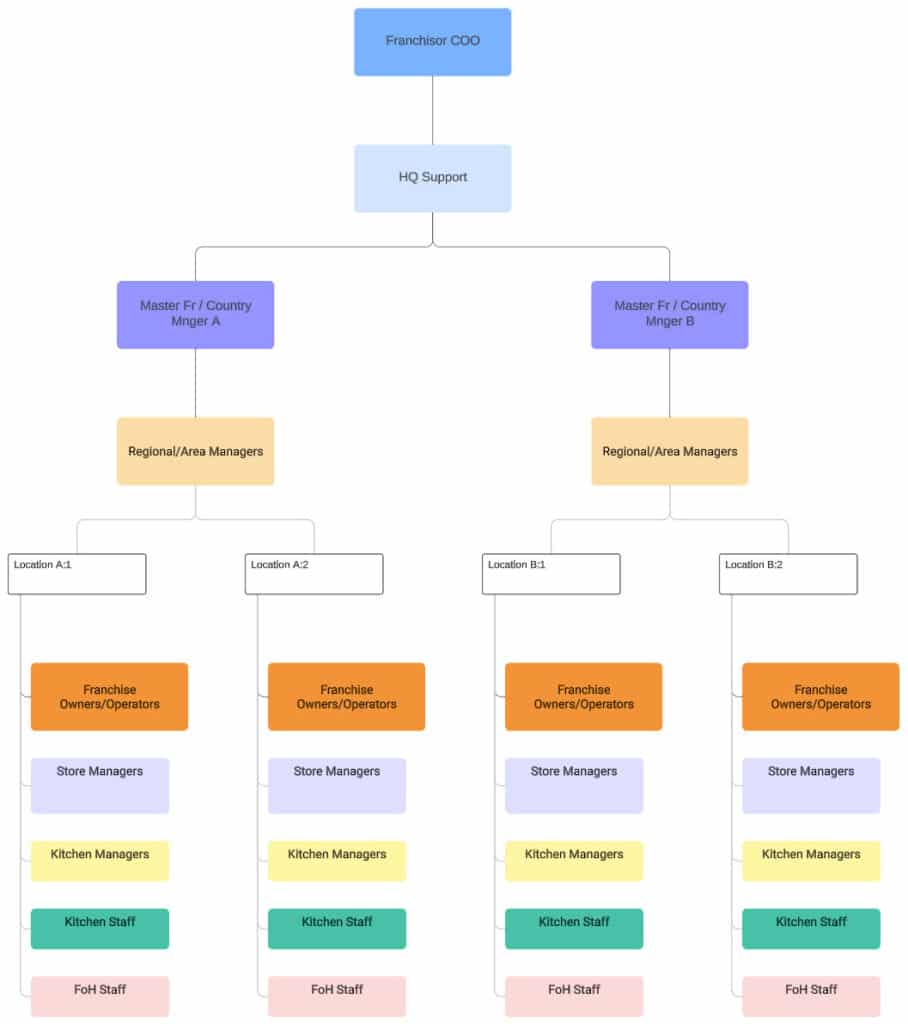In the dynamic world of franchising, effective internal communication stands as the cornerstone of success. From franchisors to Area managers and GM:s to Frontline staff, the flow of information shapes every aspect of operations, delivering stellar support, maintaining brand consistency, and enhancing overall performance.
We’d like to share some insights and experience based on more than 20 years in the franchising “internal comm’s”-industry.
Often, information and communication within an organization swing to extremes: either an overwhelming deluge, indiscriminately distributed to everyone via every conceivable channel, platform and apps, or they are scarce, delayed, and reach too few (and even the wrong) people.
This issue frequently stems from the absence of a well-defined communication framework that categorizes the organization into distinct target groups. The problem is exacerbated by the use of numerous disjointed apps and channels, coupled with uncoordinated emails, leading to confusion about who is using which platform and what tasks they are responsible for.
Here’s a list of typical areas of communication, roles/functions involved, and topics that can be relevant in such settings.
Roles/Functions in a Restaurant Franchise network:
- Franchisor/Corporate Management: Senior executives or corporate team members who oversee the entire franchise network.
- Country/Regional/Area Managers: Individuals responsible for overseeing operations in specific geographic areas.
- Franchise Owners/Operators: Individual or entities that own and operate one or more franchised units.
- Site/Store Managers: People in charge of the day-to-day operations of individual restaurant locations.
- Staff/Team Members: Frontline employees who handle various operational tasks like cooking, serving, customer service, etc. This can be further extended with even more specific Positions/Functions; Servers, Runners, Dish etc.
Explore the illustrative organizational chart tailored for an international franchise, highlighting the key roles and their interdependencies, with a focus on operational aspects – the core driver of internal communication. This chart adapts to various franchise sizes, from smaller networks to more intricate setups that include roles like Master Franchise, Multi-Unit Franchisee and Multi-Branded Operations. The ability to customize internal communication to fit each unique franchise structure is crucial for ensuring clarity, relevance, and credibility in information dissemination among all stakeholders, ensuring no one is overlooked.

In this structure, information should be able to be shared not only top down, but also across, between peers in the same roles, and even more important, internally between all roles in each location.
Typical Areas and Topics of Communication:
An example list of who’s-informing-who and what’s typically addressed between these parties.
- Operational Guidelines and Standards:
From Franchisor to Franchise Owners/Operators and Store Managers.
– Topics: Menu updates, health and safety protocols, customer service standards, Operations Manual
- Marketing and Promotions:
From Corporate Marketing to Franchise Owners/Operators and Store Managers.
– Topics: National or regional marketing campaigns, local marketing initiatives, promotional offers, access to graphical material and templates.
- Training and Development:
From Franchisor/Training Department to Store Managers and Staff.
– Topics: New employee orientation, ongoing training programs, skill development workshops.
- Performance Metrics and Feedback:
From Regional/Area Managers to GM:s, Franchise Owners and Store Managers.
– Topics: Sales performance, customer feedback, operational efficiency metrics, operational support.
- Compliance and Quality Assurance:
From Corporate Compliance Team to Gm:s and Franchise Owners/Operators.
– Topics: Compliance with brand standards, audit results, quality improvement plans.
- Supply Chain and Inventory Management:
From Corporate Supply Chain to Store Managers.
– Topics: Inventory levels, new product launches, supplier issues, supplier agreements.
- HR and Staffing:
From Franchisor HR to Franchise Owners/Operators and Store Managers.
– Topics: Hiring practices, employee policies, staff scheduling practices, hiring templates, legal information.
Why communicating with “Function” is better than with “Person”.
Communicating with functions (or roles) rather than individual persons in an organizational context, especially in a franchise setting, offers several significant advantages that contribute to increased efficiency and relevance. Here’s a breakdown of why this approach is often more effective:
Role-Based Relevance:
– Targeted Information:
Communicating based on roles ensures that the information is highly relevant to the duties and responsibilities of that role. This eliminates the noise of irrelevant information that might occur when communicating with individuals regardless of their job function.
– Efficiency in Training and Updates:
Role-specific communication is crucial for training purposes and for updating procedures or protocols, as it ensures that the right people receive the most pertinent information for their job.
Consistency and Standardization:
– Uniform Understanding:
Communicating with functions helps maintain consistency in understanding and implementing policies and procedures across the organization. Everyone in the same role receives the same message, reducing discrepancies in how different individuals might interpret the information.
– Easier Policy Enforcement:
Standardization of communication across a particular function makes it easier to enforce policies, follow up and maintain quality control.
Scalability and Time-Savings:
– Scalable Communication:
As the organization grows, communicating with functions rather than individuals becomes more scalable. It’s easier to add a new person into a pre-defined role with established communication channels than to tailor communication strategies for each new individual.
– Reduced Redundancy:
It saves time by avoiding the need to repeat the same message to multiple individuals who perform similar tasks or hold similar responsibilities within the organization. This becomes even more important the higher staff turnover you have.
Clear Lines of Responsibility and Accountability:
– Defined Responsibility:
When communication is function-based, it’s clear who is responsible for what. This clarity enhances accountability as each role knows exactly what tasks and routines it is accountable for.
– Easier Performance Tracking:
Tracking the performance of a function or role in terms of responding to and acting on communications is more straightforward than tracking this on an individual level.
Adaptability and Flexibility:
– Easier to Manage Changes:
In a dynamic work environment, roles and functions may evolve, but the essence of the role often remains consistent. Communicating with functions allows for a smoother transition and adaptation to changes within the organization.
– Flexibility in Staffing:
In high staff turnover businesses like F&B, retail etc, the ability to have information shared by role immensely reduces the overhead admin load when new staffers are coming and going at the speed of a revolving door.
With role-based communication, it’s easier to manage staffing changes. New employees or temporary replacements can quickly be brought up to speed as they step into a role with established communication, already shared information channels and expectations.
In summary, function-based communication in an organization like a franchise is a strategic approach that enhances efficiency, consistency, and effectiveness. It aligns communication with the operational structure of the business, ensuring that the right people get the right information at the right time, which is pivotal for smooth operations and overall organizational success.
It’s like we’ve finally broken the endless loop of ‘How do I do this?’ and ‘Where can I find that?’
Exceptions to the rule:
In certain situations, communicating directly with individuals, rather than addressing their roles, is more effective and appropriate within an organization.
Examples:
Personalized Feedback and Performance Reviews: For offering tailored guidance, discussing career development, and addressing specific performance aspects.
Recognition and Appreciation: Acknowledging individual contributions, celebrating personal milestones, and expressing gratitude for unique achievements. (this could be shared in a wider scale to treat winners as winners..)
Sensitive or Confidential Matters: Addressing private or personal issues, including health, HR matters, or conflicts, which require confidentiality and a sensitive approach.
Customized Training or Support: Catering to unique learning needs or offering additional support for specific challenges faced by an employee.
Direct Requests or Queries: Responding to individual-specific inquiries or providing instructions for tasks unique to a particular employee.
Building Relationships and Rapport: Developing mentor-mentee relationships, offering personal guidance, and understanding individual perspectives through one-on-one interactions.
Emergency or Urgent Situations: Dealing with issues that require immediate attention or intervention on an individual level, especially in emergencies or time-sensitive circumstances.
How the Chainformation Platform fits in this context:
Chainformation can facilitate and streamline these communication strategies through:
- Centralized Communication Hub: Ensuring all stakeholders receive consistent and timely information through a single unified Brand hub.
- Role-Based Access and Permission Customization: Tailoring communication based on roles and responsibilities to ensure relevance and avoid information overload, as well as offering the option for person-to-person messaging.
- Automated Notifications and Reminders: Keeping all parties informed about important updates and deadlines. Real-time push notifications on mobile devices.
- Automate and schedule digital checklists: For daily, weekly, monthly, or seasonal tasks and routines. Set deadlines, reminders, and notifications for checklists, monitor progress and completion of your franchisees and staff.
- Data and Analytics Reporting: Providing tools for sharing operational performance metrics and feedback effectively.
Built in Read-statistics to track who’s missing or skipping important updates. - Document Management: Ensuring easy access to operational guidelines, training materials, and compliance documents. Change log version management and traceability.
- Feedback and Survey Tools: Enabling real-time chat-based feedback from franchisees and store managers to the corporate team. Seamless support and issue handling.
I picked these snippets up in a conversation at the dinner table attending a customer’s yearly franchise conference:
“Since rolling out Chainformation, I’ve noticed a huge drop in those same old questions we used to get bombarded with every day. It’s like we’ve finally broken the endless loop of ‘How do I do this?’ and ‘Where can I find that?”
“My GM’s and most important, their staff now have direct access to all the info they need, at the flick of a thumb.”
“Surprisingly, onboarding new folks has become way better thanks to tasks and checklists in the app guiding them along. They’re up to speed faster, and it’s saving us all a ton of time and headache.”
Let us show you how implementing Chainformation provides a structured and efficient way to manage these varied communications, ensuring that each level of your franchise network stays well-informed and aligned with the brand’s objectives and standards. Invest 20 minutes for a Zoom call and go: “-Heck! That’s some clever system you have..!!”



